
Eyeball is a 1975 Italian giallo slasher film written and directed by Umberto Lenzi.
A slasher film is a subgenre of horror films involving a killer stalking and murdering a group of people, usually by use of bladed or sharp tools. Although the term "slasher" may occasionally be used informally as a generic term for any horror film involving murder, film analysts cite an established set of characteristics which set slasher films apart from other horror subgenres, such as monster movies, splatter films, supernatural and psychological horror films.
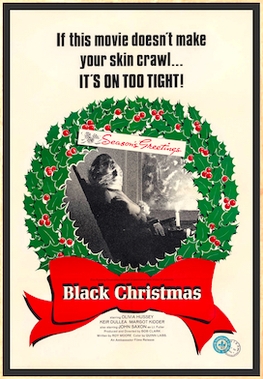
Black Christmas is a 1974 Canadian slasher film produced and directed by Bob Clark, and written by Roy Moore. It stars Olivia Hussey, Keir Dullea, Margot Kidder, and John Saxon. The story follows a group of sorority sisters who receive threatening phone calls and are eventually stalked and murdered by a mentally ill killer during the Christmas season.

The Amityville Horror is a 2005 American supernatural horror film directed by Andrew Douglas and starring Ryan Reynolds, Melissa George, and Philip Baker Hall. It also featured the debut of actress Chloe Grace Moretz. Written by Scott Kosar, it is based on the novel The Amityville Horror by Jay Anson, which was previously adapted into the 1979 film of the same name, while also serving as the ninth film in the Amityville Horror film series, which documents the experiences of the Lutz family after they move into a house at 112 Ocean Avenue, Long Island. In 1974, real-life mass murderer Ronald DeFeo Jr. killed six members of his family at the same house in Amityville, New York.

Silent Night, Deadly Night is a 1984 American slasher film directed by Charles E. Sellier, Jr., and starring Robert Brian Wilson, Lilyan Chauvin, Gilmer McCormick, Toni Nero, Linnea Quigley, Britt Leach, and Leo Geter. The story concerns a young man named Billy, who suffers from post-traumatic stress over witnessing his parents' murder on Christmas Eve by a man disguised as Santa Claus and his subsequent upbringing in an abusive Catholic orphanage. In adulthood, the Christmas holiday leads him into a psychological breakdown, and he emerges as a spree killer donning a Santa suit.

Black Sunday is a 1960 Italian gothic horror film directed by Mario Bava in his official directorial debut, and starring Barbara Steele, John Richardson, Andrea Checchi, Ivo Garrani, Arturo Dominici and Enrico Oliveri. Loosely based on Nikolai Gogol's short story "Viy", the film takes place in Moldavia and tells the story of a witch who is put to death by her brother, only to return two centuries later to seek revenge upon his descendants.

Night of the Demon is a 1980 American horror film directed by James C. Wasson, written by Jim L. Ball and Mike Williams, and starring Michael Cutt, Joy Allen, Robert Collings, Jodi Lazarus, Richard Fields, Michael Lang, and Melanie Graham. The film centers on an anthropologist who, along with a group of his pupils, embarks on an expedition to prove the existence of Bigfoot in a rural region of Northern California, only to be stalked and systematically slaughtered by the creature.

Happy Birthday to Me is a 1981 slasher film directed by J. Lee Thompson and starring Melissa Sue Anderson and Glenn Ford. Its plot revolves around six brutal murders occurring around a popular high school senior's birthday.
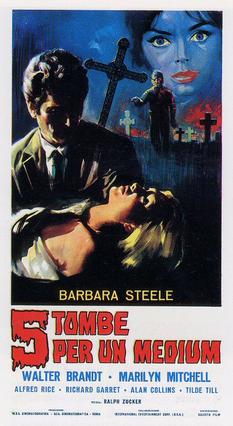
Terror-Creatures from the Grave is a 1965 horror film directed by Domenico Massimo Pupillo. The film was an international co-production between Italy and the United States through M.B.S. Cinematografica, G.I.A. Cinematografica and International Entertainment Corp.
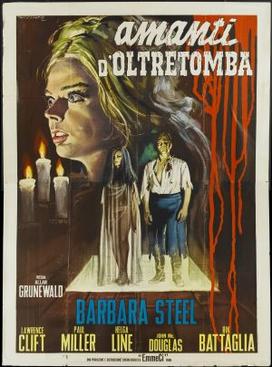
Nightmare Castle is a 1965 Italian horror film directed by Mario Caiano. The film stars Paul Muller, Helga Liné and Barbara Steele in a dual role.
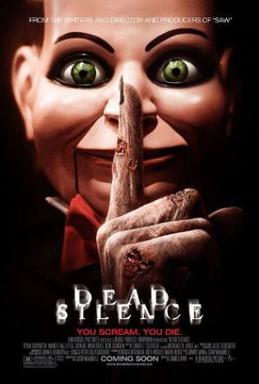
Dead Silence is a 2007 American supernatural horror film directed by James Wan and written by Leigh Whannell. The film stars Ryan Kwanten as Jamie Ashen, a young widower returning to his hometown to search for answers to his wife's death. It also stars Amber Valletta, Donnie Wahlberg, and Bob Gunton.
The Grudge is an American supernatural horror film series released by Sony Pictures based on and a part of the larger Japanese Ju-On franchise. The first installment is a remake of Ju-On: The Grudge and follows a similar storyline to the Japanese film. The sequel, The Grudge 2, is not a remake and follows a unique storyline, albeit still borrowing some plot elements from several Japanese predecessors. Another sequel, The Grudge 3, picks up shortly after the events of the second film.

I Know Who Killed Me is a 2007 American psychological thriller film directed by Chris Sivertson, written by Jeff Hammond, and starring Lindsay Lohan, Julia Ormond, Neal McDonough and Brian Geraghty. The film's story revolves around a young woman who is abducted and tortured by a sadistic serial killer. After surviving the abduction, she insists that her identity is that of another woman.

The Slayer is a 1982 American independent supernatural horror film directed by J. S. Cardone. Set on a small island near the Atlantic coast, the plot concerns two couples who upon visiting the island get trapped there due to an oncoming hurricane. As one of the women knows from her plaguing nightmares that the island is dangerous, over the next three days they begin to be killed by something unseen. The film is notable for gaining notoriety and being classified in the United Kingdom as a "video nasty" in the 1980s.

Halloween is a 1978 American independent slasher film directed, co-written, and scored by John Carpenter. Starring Donald Pleasence and Jamie Lee Curtis, with P. J. Soles and Nancy Loomis in supporting roles, the film is set mostly in the fictional town of Haddonfield, Illinois. The plot centers on a mental patient, Michael Myers, who was committed to a sanitarium for murdering his teenage sister on Halloween night when he was a child. Fifteen years later, having escaped and returned to his hometown, he stalks teenage babysitter Laurie Strode and her friends while under pursuit by his psychiatrist Dr. Samuel Loomis.
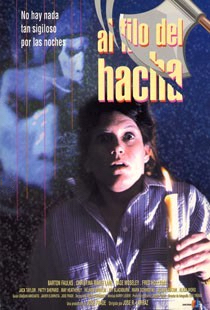
Edge of the Axe is a 1988 English-language Spanish slasher film directed by José Ramón Larraz, and starring Barton Faulks, Christina Marie Lane, Page Moseley, and Fred Holliday. The film centers on a masked maniac murdering people in a rural mountain town in Northern California.

Cries in the Night, more popularly released as Funeral Home, is a 1980 Canadian slasher film directed by William Fruet and starring Lesleh Donaldson, Kay Hawtrey, Jack Van Evera, Alf Humphreys, and Harvey Atkin. The plot follows a teenager spending the summer at her grandmother's inn—formerly a funeral home—where guests begin to disappear.

Sledgehammer is a 1983 independent slasher film written and directed by David A. Prior. The film tells the story of a young boy who murdered his mother and her lover with a sledgehammer. Ten years after the murder and the child's mysterious disappearance, a group of teens stay in the house for a weekend when they are terrorized by the ghost of the little boy.

Billy is a fictional character from the Black Christmas film series, first appearing in Black Christmas (1974) as a deranged murderer who taunts and kills a group of college students during the Christmas season. Created by Bob Clark and A. Roy Moore, the character was partly inspired by the urban legend "The Babysitter and the Man Upstairs", as well as a series of real murders in Montreal during the 1943 holiday season.

Lisa Frankenstein is a 2024 American comedy horror film directed by Zelda Williams, in her feature-length directorial debut, and written by Diablo Cody. The film stars Kathryn Newton, Cole Sprouse, Liza Soberano, Henry Eikenberry, Joe Chrest, and Carla Gugino. The plot follows a misunderstood teenage goth girl who meets and develops a relationship with a reanimated Victorian-era corpse. Cody stated that Lisa Frankenstein is set in the same fictional universe as Jennifer's Body.

















